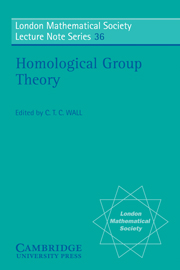Book contents
- Frontmatter
- Contents
- Preface
- Introduction
- 1 Traces and Euler characteristics
- 2 Groups of virtually finite dimension
- 3 Free abelianised extensions of finite groups
- 4 Arithmetic groups
- 5 Topological methods in group theory
- 6 An example of a finite presented solvable group
- 7 SL3(Fq[t]) is not finitely presentable
- 8 Two-dimensional Poincaré duality groups and pairs
- 9 Metabelian quotients of finitely presented soluble groups are finitely presented
- 10 Soluble groups with coherent group rings
- 11 Cohomological aspects of 2-graphs. II
- 12 Recognizing free factors
- 13 Trees of homotopy types of ( m)-complexes
- 14 Geometric structure of surface mapping class groups
- 15 Cohomology theory of aspherical groups and of small cancellation groups
- 16 Finite groups of deficiency zero
- 17 Äquivalenzklassen von Gruppenbeschreibungen, Identitäten und einfacher Homotopietyp in niederen Dimensionen
- 18 Two-dimensional complexes with torsion values not realizable by self-equivalences
- 19 Applications of Nielsen's reduction method to the solution of combinatorial problems in group theory: a survey
- 20 Chevalley groups over polynomial rings
- List of problems
5 - Topological methods in group theory
Published online by Cambridge University Press: 05 April 2013
- Frontmatter
- Contents
- Preface
- Introduction
- 1 Traces and Euler characteristics
- 2 Groups of virtually finite dimension
- 3 Free abelianised extensions of finite groups
- 4 Arithmetic groups
- 5 Topological methods in group theory
- 6 An example of a finite presented solvable group
- 7 SL3(Fq[t]) is not finitely presentable
- 8 Two-dimensional Poincaré duality groups and pairs
- 9 Metabelian quotients of finitely presented soluble groups are finitely presented
- 10 Soluble groups with coherent group rings
- 11 Cohomological aspects of 2-graphs. II
- 12 Recognizing free factors
- 13 Trees of homotopy types of ( m)-complexes
- 14 Geometric structure of surface mapping class groups
- 15 Cohomology theory of aspherical groups and of small cancellation groups
- 16 Finite groups of deficiency zero
- 17 Äquivalenzklassen von Gruppenbeschreibungen, Identitäten und einfacher Homotopietyp in niederen Dimensionen
- 18 Two-dimensional complexes with torsion values not realizable by self-equivalences
- 19 Applications of Nielsen's reduction method to the solution of combinatorial problems in group theory: a survey
- 20 Chevalley groups over polynomial rings
- List of problems
Summary
Introduction
This article is a revised version of notes on an advanced course given in Liverpool from January to March 1977 in preparation for the symposium. The lectures given by Terry Wall at the symposium were mainly taken from Sections 3 and 4, and much of the material in John Stallings' lectures is in Sections 5 and 6. It seemed worth publishing the whole, as a rather full introduction to the area for those with a background in topology. Originality is not claimed for the results in the earlier sections (though full references have not always been given), but the uniqueness results in Section 7 and most of Section 8 are due to Peter Scott.
BASIC NOTIONS
The link between topology and group theory comes from the fundamental group. I shall make no attempt to present this: almost every introductory topology text does so. Particularly suitable for this course is Massey's book [18]. An equivalent account, from a different viewpoint, is given by Brown [2], Let us recall the basic properties of the fundamental group.
(1) For every topological space X and point x ϵ X we have a group π1 (X; x). This depends only on the path component of X containing x. A path from x to y induces an isomorphism π1 (X; x) → π1 (X; y); a closed path induces an inner automorphism.
- Type
- Chapter
- Information
- Homological Group Theory , pp. 137 - 204Publisher: Cambridge University PressPrint publication year: 1979
- 134
- Cited by



